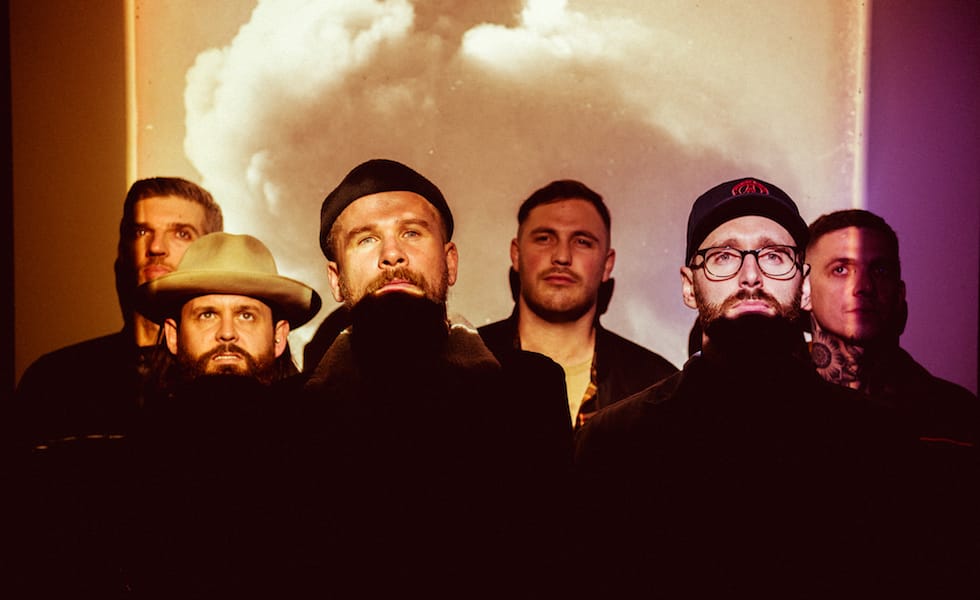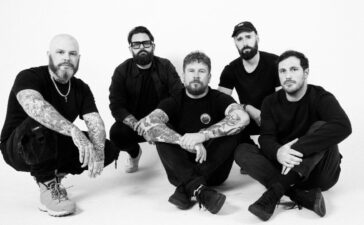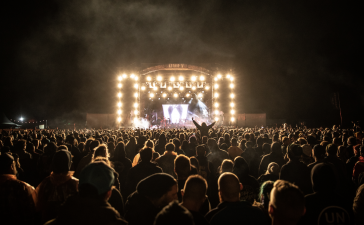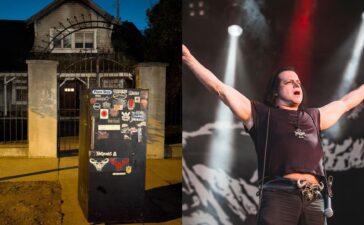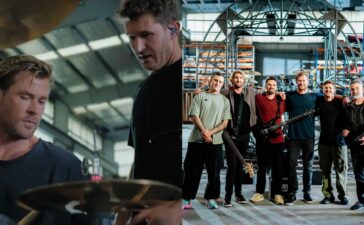Aboriginal and Torres Strait Islander readers please be advised this article discusses highly sensitive and traumatic events of The Frontier Wars, Massacres and Sorry business.
For Chasing Ghosts’ recent Homelands EP, frontman Jimmy Kyle penned a song based on one of many horrific chapters of The Frontier Wars that absolutely decimated the population of the Thungutti Nation, an all too familiar experience during the 1850s in the colony of NSW. We know this – it was an overt message placed front and centre, void of any whimsical metaphor; lead single ‘Summer’ is quite literally about The Towel Creek Massacre in 1856 where many Thungutti First Nations men, women and children (including babies) were murdered, leaving a sole survivor – a small child, Baabang Jack Scott. We know ‘Summer’ is a good song. It’s a heavy hitter on an album populated by heavy hitting tracks that’s earned thunderous applause from both fans and critics.
We know about The Port Arthur Massacre and its impact that rippled throughout Australia after the tragic murder of 35 people that additionally left scores more injured in 1996 and led to nation gun reform. We grieved as a nation in solidarity for those taken that day and continue to commemorate and remember those taken that day. We know about the Strathfield Massacre, which tragically left eight people dead in 1991 and families broken with grief.
But what do we know about The Frontier Wars and subsequent massacres? What do we know about the largely state-approved massacres that some estimates attribute to murdering close to 90% of Australia’s Indigenous population between 1788 and as recent as 1930?
It’s time to educate ourselves and with the release of Homelands and ‘Summer’, we’re afforded an opportunity to do just that. So, rather than profiling the tour dates, or the release, Blunt Magazine & Jimmy have taken the opportunity to profile some of the injustices.
In the coming weeks, fans of Chasing Ghosts will be gathering at cities on their ‘Colonies Tour’ across the land. Here is a fraction what happened in those cities and their surrounds.
Naarm (Melbourne)
Specific records for the massacres carried out by the invading Red Coats, Colonial Police, Native Mounted Police, squatters, pastoralists, elected members of government, and whalers are few and far between, some lost to the sands of time, some no doubt on purpose.
The Frontier Wars arrived in Victoria around 1833, with the Convincing Ground Massacre of the Gunditjmara Nation which left an estimated 200 members of the local Kilcarer Clan murdered. For context, it was later revealed that only two members of the Kilcarer Clan survived the clash between European whalers. This massacre was led by Edward Henty, an elected member of the Electoral district of Port Phillip.
In 1838 alone, three massacres would take place in and around Naarm (MEL) including up to 100 Aboriginal People murdered in retaliation for the death of eight European settlers during The Battle of Broken River. The Mount Cottrell Massacre resulted in the deaths of 10 Wathaurong People and The Waterloo Plains Massacre which claimed the lives of up to 23 members of the Dja Dja Wurrung People. Just the following year, The Campaspe Plains Massacre occurred with 40 Taungurong People murdered, with European occupiers returning soon after to execute six more Taungurong People, all of whom were shot in the back as they fled. In the short space between 1840 and1846, it’s estimated more than 2,000 Aboriginal People were murdered by European colonialists – this included the cold-blooded Warrigal Creek Massacre which saw up to 150 Gunai/Kurnai People murdered by a group of European pastoralists known as the Highland Brigade, led by Scottish squatter Angus McMillan, whose penchant for murdering First Nations’ Peoples stands out even for this context. Throughout Victoria, there are around 60 statues, monuments, and dedications to Angus McMillian who, like Edward Henty, was an elected member of the Electoral district of Port Phillip and a murderer.
Tarndanya (Adel)
Another example of these massacres during The Frontier Wars is in a roughly 12-month period – two massacres occurred and like all of these horrific moments, they still reverberate through the Aboriginal population. The Avenue Range Station Massacre of 1848 saw nine of the Buandig Wattatonga Clan murdered at the hand of pastoralist and station owner James Brown, who was arrested for the crimes but released on account of no witnesses coming forward. The following year, it’s believed two to three settlers were killed by a local Clan. The retaliation led by European settlers is now known as The Waterloo Bay Massacre. Official records suggest around 10 Nauo People were murdered, however there are contested reports that the figure is closer to 250 executed on the cliffs of the Eyre Peninsula. It wasn’t until 2017 that the local council memorialised the massacre, after numerous unsuccessful attempts from advocates dating back decades.
Meanjin (Bris)
The Frontier Wars manifested in some of the bloodiest and most shocking massacres to have happened throughout the 140-year resistance to British occupation. There are confirmed reports of mass poisonings of Indigenous people living in the now-called Killcoy and Whiteside regions with an estimated 200 killed between 1842 and 1847 due to flour spiked with the poison Strychnine.
In the years and decade following, literal countless massacres would happen throughout Queensland, many with casualties simply too high to accurately collect, including the Goulbolba Hill Massacre 1867 which left an estimated 300 men, women, and children dead – either by bullet or drowned in the nearby lake. Mere months later, a similar number of casualties occurred during the The Leap Massacre at Mt Mandarana, where, after spearing some nearby cattle due to starvation, a group of Indigenous People plunged to their death rather than facing the impending onslaught of gunfire.
Warrane (Sydney)
By most accounts, the NSW Colony is where The Frontier Wars first broke, making it a timely and important finale for the Colonies Tour. In 1801, following fierce resistance from one of the many Aboriginal warriors’ Pemulwuy, Governor Philip Gidley King declared that ‘settlers’ could shoot Indigenous People on site, with no risk of punishment from the English law, doubling down on a move by Governor Arthur Phillip a decade earlier to arm the Europeans with muskets, should they encounter any of the Traditional Landowners. But it’s safe to say colonialists weren’t looking for approval as in 1879, seven Bidjigal People were murdered for stealing clothing from British colonialists. One surviving young child was tortured, dragged through an open flame before eventually being shot.
By 1836, little to no care was given regarding the murder of Indigenous People in the colony of NSW. Major Thomas Mitchell, after merely feeling threatened by a group of 150 Aboriginal people, issued an order to his troops to push the group into the Murray River, where another regiment would open fire on them as they swam to safety in what is now called the Mount Dispersion Massacre. Mitchell faced no recourse for his actions and subsequently named the location Mount Dispersion after his effort.
The Waterloo Creek Massacre, also known as The Australian Day Massacre, took place two years later after Colonel Kenneth Snodgrass sent troops to attack a group of Gomilaroi people. Official figures are contested but Snodgrass himself boasted a total of 300 dead.
The above is merely a glimpse of a fraction of the atrocities committed against the Indigenous population which was believed to be around at least 750,000 in total prior to the British Crown usurping the lands for their own interest. There are far too many confirmed reports to fit into one piece of editorial, nor would we want to limit the scope by whittling them down to mere dates and figures. This is now a resource, a springboard for you to launch into your own personal research.
If you, like Team Blunt, are left with a chill at your own lack of knowledge around The Frontier Wars, perhaps one of the upcoming Chasing Ghosts tour dates is exactly where you need to find yourself.
Chasing Ghosts’ ‘Homelands Colonies’ tour dates
Friday 30th, July
Hotel Westwood, Naarm
Tickets: Eventbrite
Saturday, 31st July
Cherry Bar, Naarm
Tickets: Cherry Bar
Saturday, 14th August
Enigma Bar, Tarndanya
Tickets: Moshtix
Saturday, 28th August
The Brightside, Meanjin
Tickets: Eventbrite
Saturday, 4th September
Chippendale Hotel, Warram
Tickets: Music Booze Co.


